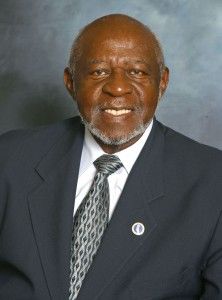Cal State Pay Scandal Repeats 1990

By JOHN HRABE
Under Herbert Carter’s tenure, the Cal State University system has approved “hefty salary increases” for its top executives “without public input” during the state’s “most dire funding predicament.”
Those aren’t quotes from recent news stories about the Cal State’s administrative pay scandal. CalWatchdog has rummaged through the archives and unearthed the news stories from the Cal State’s first executive compensation scandal.
The two scandals at the Cal State University system are eerily similar. In 1989-90, the Cal State University system quietly approved outrageous executive salaries during lean budget years, blamed the Legislature for its tuition increases, temporarily appeased angry legislators with phony solutions, then tricked the public with clever public relations gimmicks.
Twenty-two years later, about the only thing that’s changed is Carter’s title. Then, Carter served as the Cal State’s Executive Vice Chancellor, the system’s second-in-command who took over when CSU Chancellor Ann Reynolds resigned in disgrace. Now, he’s the chairman of the Cal State Board of Trustees.
In the words of Shirley Bassey and the Propellerheads,
“It’s all just a little bit of history repeating.”
This week, as the California Senate contemplates Carter’s reconfirmation to another eight-year term on the Cal State Board of Trustees, Senators can avoid repeating history if they heed the advice of Assemblyman Anthony Portantino, D-La Canada-Flintridge. He warned in 2007, “We simply cannot trust the CSU Board of Trustees to reform itself.”
Salary Increases: Then and Now
In March 1990, the San Francisco Chronicle’s Greg Lucas reported that CSU Chancellor Reynolds was grilled by legislators “over hefty salary increases she gave herself and 26 other top executives in the California State University system.” When State Senator Nicholas Petris, D-Oakland, tried to ask Reynolds about the salary hikes, “Reynolds stood up, took a seat in the audience and directed her second-in-command, Herbert Carter, to answer the questions.”
Carter was well-qualified to discuss the salary increases because he was one of the lucky recipients of the taxpayer-funded pay hike. He received a $31,026 raise, taking his annual salary from $118,974 to $150,000. According to the Los Angeles Times, Carter’s 26 percent salary increase was the highest of the six vice chancellors.
Carter and other system-wide administrators weren’t the only public employees to profit. The system’s 20 campus presidents received an average pay raise of 17 percent, bringing annual salaries up to $150,000. The raises “were implemented without public hearings or a vote of the CSU board of trustees.”
The 1990 pay raise story mirrors Cal State’s current executive compensation scandal. Last July, at the same meeting in which Trustees approved a 12 percent tuition increase, the board authorized a $400,000 annual salary for incoming San Diego State President Elliot Hirschman. The new job gave Hirschman’s a $133,000 increase compared to his previous salary. As the provost and senior vice president of the University of Maryland, Baltimore County, he made $267,000 per year. Currently, Cal State presidents receive a compensation package worth an average of $372,000 per year.
Luxurious Perks for Government Employees
Back in 1990, it wasn’t just outrageous salaries that infuriated the public. “Besides the raises, [CSU Chancellor] Reynolds has been attacked for using CSU funds to renovate her Bel Air home and to purchase new cars for senior administrators,” the Orange County Register reported on April 21, 1990.
The Chancellor’s office spent $99,998.70 on new vehicles for six vice-chancellors. Carter was among this exclusive group of administrators that received a taxpayer-funded car, according to the Chronicle. The amount, just $1.30 short of six-figures, was cleverly kept under $100,000 in order to avoid “an automatic review by the state Department of Finance.”
Today, Cal State University is back to using taxpayer funds to provide special perks and bonuses to its top administrators. Each Cal State president receives up to $60,000 per year in a housing allowance and $12,000 per year for a car allowance. Cal State presidents earn more in housing and car allowances than the average Californian earns in his annual salary. But, don’t accuse Carter of being out of touch.
“I need to remember what it’s like to be poor, hungry and without a decent place to live,” Carter told the Los Angeles Business Journal for a January 1990 profile. “I avoid the freeway and drive on the surface streets through downtown L.A. on purpose.”
The Bureaucrat Who Cried Budget Cuts
Cal State’s top brass have enjoyed these lavish benefits, while blaming the Legislature for budget cuts to higher education. Cal State’s press office didn’t mince words last summer with its press release announcing the 12 percent fee hike. It blamed Gov. Brown by the release’s second word.
“Following Governor Brown’s signing of a final budget that cuts state funding for the California State University by $650 million for 2011-12, the CSU Board of Trustees took action today to increase tuition by an additional 12 percent — or $294 per semester for full-time undergraduates — effective in the fall,” according to the July 12 press release.
In the same release, CSU Chancellor Charles B. Reed explained, “The enormous reduction to our state funding has left us with no other choice if we are to maintain quality and access to the CSU.”
This blame game continued a few months later. “In two of the last four fiscal years, state funding to the CSU has been dramatically reduced, forcing the board to approve sizable tuition fee increases,” read a Dec. 13 CSU press release.
Twenty years ago, Cal State was using the same “Chicken Little” excuses of unprecedented budget cuts. The CSU Chancellor’s office described the 1990’s budget period as “the most dire funding predicament we have faced.”
Same Excuses for High Administrative Salaries
After budget cuts, the Cal State system’s response protocol dictates an emphasis on the importance of being competitive with other institutions. Carter even recycled the same talking points from the previous executive compensation scandal.
“Carter said the increases are necessary to keep CSU executive salaries competitive with those of other learning institutions,” reported the San Francisco Chronicle on March 20, 1990.
Compare that to today.
“The new compensation limits and more relevant tiered list of comparator institutions will give stakeholders a good benchmark of where presidential compensation will be set as we move forward,” Carter said in a January 2012 press release. “Our continued goal is to recruit and compete for the best leadership possible, but also within articulated budget guidelines.”
Pressure Continues? Appoint a Special Committee
Press releases only go so far in assuaging outraged politicians. When Gov. Jerry Brown objected to the salary abuses, Carter responded by forming a special committee to study the issue.
“Carter, who was reappointed by the governor earlier this year, addressed it, saying he would create a committee to study the selection and compensation of CSU presidents and have the committee report back to the board at its September meeting. He did not suggest altering Hirshman’s pay package,” the San Diego Union Tribune wrote in July 2011.
Carter was using the same playbook from the 1990 scandal. The New York Times reported in April 1990:
“On Thursday, a subcommittee of the trustees recommended rolling back the salaries of 26 executives to previous levels. The recommendation, presented to a special meeting of the board today, was approved just after Ms. Reynolds resigned, effective Dec. 31…. The subcommittee made the recommendation after taking testimony on the raises, which included a 43 percent increase for Ms. Reynolds, and an average 17 percent raise for 20 campus presidents.”
Behind Closed Doors
When the public doesn’t buy this spin, Cal State’s tactic is to retreat to secretive meetings. During the first scandal, the pay raises were approved without a public vote by the Cal State Board of Trustees, in violation of a 1984 pledge by the chancellor’s office. In April 1990, the Los Angeles Times reported that the Cal State Chancellor’s office apologized for breaking that earlier pledge and that “future actions on executive pay would be in public.”
Carter defended the secrecy, telling the Chronicle in 1990, “The process is fair and legal but the perception is not that.” His commitment to secrecy in government hasn’t changed in two decades. In November 2011, Lt. Governor Gavin Newsom charged the Cal State Board of Trustees, under Carter’s chairmanship, with violating the spirit of the Brown Act when it hid from the public.
“While I understand the CSU leadership’s concerns regarding public safety, the spirit of open deliberations has been marred by the events of November 16, 2011,” Newsom wrote. “This issue is simply too important to not allow for a full and thorough discussion. Otherwise, we contribute to the perception that this process is anything less than open and transparent.”
Carter affirmed his fear of the public by canceling the Trustees’ Dec. 5 meeting. “We made this decision based upon our experience at the last board meeting where a large number of protestors attended, which is difficult to manage under the best of circumstances,” Carter said in the Nov. 30 press release.
California Faculty Association’s Tough Talk
All these years, students and faculty haven’t been without a strong voice for accountability. The California Faculty Association, then and now, has been quick to criticize the CSU administration for its irresponsible spending practices.
“These things [should] be voted on in public session so people know where [the trustees] stand on spending public money,” Robert Gurian, the lobbyist for the California Faculty Association, told the Chronicle. ”The state’s in dire financial consequences and yet you open up the newspaper and see this enormous pay raise.”
Can you tell the difference between then and now?
“It is complete arrogance and tone deafness to be doing something like this while students are being knocked sideways by pretty staggering fee increases year after year,” said the California Faculty Association’s president, Lillian Taiz. “For those of us who have been struggling and working on helping the public understand the value of higher education and investment in higher education … it doesn’t send the right message.”
Taiz is from today; Gurian from 20 years ago.
Let’s try again:
“There’s no proof I know of whatsoever that we pay our administrators inadequately,” said Gurian. ”The No. 1 priority of the CSU administration is the administration.”
“Working for the university is about performing public service, not becoming a CEO in private industry. Commitment to public service must be a key criteria in assessing potential CSU campus presidents.”
No, that last part isn’t an extension of Gurian’s quote. It’s from an August 2011 press release from the current CFA President Taiz.
In 1990, Edward R. Purcell, then the general manager of the faculty union, gave the harshest critique of the Cal State administration. He called it “a hidebound bureaucracy which basically thinks it’s above the law and . . . would like to be running a private institution.”
Carter: ‘Master of Working Within the System’
With such consistent tough talk from the California Faculty Association, why have Cal State faculty members been so quick to give in to the administration’s demands for pay cuts and furloughs? In 2009, the California Faculty Association agreed to take two furlough days a month, the equivalent of a 9.5 percent of their salary, in order to stave off greater budget cuts.
A 1990 Los Angeles Business Journal profile of Carter has one possible explanation. Harvey Lehman Jr., then a vice president at Columbia Pictures Entertainment Inc., offered insight into Carter’s leadership style. “Herb is a master of working within the system,” Lehman said. “He knows how to make everyone feel good, from people at the high corporate level to the worker at the community organization.”
Under Carter’s tenure as Cal State chair, the faculty at the bottom have been made to “feel good” with cheap perks. For example, San Francisco Chronicle columnists Phillip Matier and Andrew wrote about a recent example of one way that CSU administrators have placated faculty:
“California State University East Bay professors who played hooky to protest state budget cuts — but then put in for a full day’s pay — are getting a pass from the system’s chancellor. The chancellor said, CSU didn’t have the money for a full investigation into who had actually worked — and it would be unfair to dock the pay only of those who owned up to going out on strike. Hence, everyone will get a pass.”
Cal State’s Record of Phony Solutions
The final step in Carter’s pay-hike response procedure is to adopt a temporary and phony pay cap. This past January, the board approved a new compensation policy after public outcry following the trustees’ approval of the $400,000 annual salary for San Diego State University President Hirshman. CSU spokesman Erik Fallis recently told the Daily 49er, Cal State Long Beach’s student newspaper, “Carter is the one who recommended the change in policy.”
However, CalWatchDog.com has reported on the numerous loopholes in the Cal State’s new executive compensation policy. The carefully worded cap allows the board to continue its controversial policy of supplementing executive pay through university foundations. CSU Chancellor Charles Reed, San Jose State’s Mohammad H. Qayoum, San Diego State’s Hirshman and Cal Poly San Luis Obispo’s Jeffrey Armstrong currently receive foundation bonuses ranging from $25,000 to $50,000 per year.
State Sen. Leland Yee, D-San Francisco, has seen through the Cal State’s phony pay cap from the start. “While I am pleased to see CSU Board of Trustees finally recognize that their past executive compensation practices were completely unacceptable, their new policy just doesn’t go far enough,” Yee said. “Those making hundreds of thousands of dollars should not receive double-digit pay increases during bad budget times or when students are forced to foot the bill.”
In 1990, the trustees adopted a temporary reduction in administrative pay. The Los Angeles Times reported in April 1990, “The trustees voted unanimously Friday to rescind the Jan. 1 raises, which had boosted Reynolds’ salary 43 percent from $136,248 last year to $195,000 and those of the six vice chancellors and 20 campus presidents 21 percent to 28 percent, to totals ranging from $130,000 to $150,000. Now their salaries will go up 4.18 percent from last year’s, reflecting the average raise for faculty and other staff.”
Twenty years later, Hirshman’s salary is back up to $400,000 per year. And that ranks him second to CSU Chancellor Charles Reed, who receives $451,500 in base pay.
Sen. Lieu: Ignorant or Naïve?
As of this writing, the Senate Republican Caucus appeared to be unwavering in its opposition to Carter’s reconfirmation. Meanwhile, Gov. Brown, Senate President Pro Tem Darrell Steinberg, D-Sacramento, and Sen. Ted Lieu, D-Torrance, have steadfastly defended Carter’s confirmation.
“He is the kind of trustee that you want — someone who will respond to what students, faculty and legislators say to him — and it would be a shame if he is not reconfirmed,” Lieu recently told the Los Angeles Times.
Again, it’s almost indistinguishable from the Democratic leaders in 1990. The Los Angeles Times reported in 1990 that Democratic Lt. Governor Leo McCarthy and Assembly Speaker Willie Brown helped the then-CSU chancellor, Reynolds, beat back her initial challenge following the pay scandal.
Reynolds eventually resigned. Carter now appears on his way out, too. In April 1990, the Orange County Register editorial board cautioned that one bureaucrat’s removal should be the starting point, not the end of legislative vigilance. “Ms. Reynolds is leaving, but the Legislature shouldn’t use her exit as an excuse to allow business as usual at CSU,” the paper editorialized.
What’s the rest of that Propellerheads’ song?
“and I’ve seen it before
“and I’ll see it again
“yes I’ve seen it before
“just little bits of history repeating.”
————————————————————–
Related Articles
Izumi study sparks law promoting online learning
Maybe things actually are starting to change for the better in California’s embattled public schools. The latest: Kids who enroll
L.A. Times education reporter: Oblivious or in the tank?
Oct. 25 By Chris Reed The Los Angeles Times is the biggest newspaper in the state by far, presumably staffed
What IS going on in CA schools?
California’s government school students score among the lowest on national tests. Now this: Uproar over classroom scuffle reflects a profession





